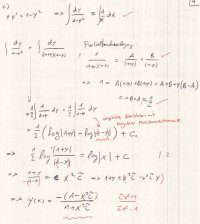While solving differential equations I noticed that I repeatedly made one specific error which can best be demonstrated with this simple example:
y′=1−y
Seperation of variables:
1−ydy=dx
⟹∫1−ydy=∫dx
u-sub with u=y−1 for the left integral gives
log∣1−y∣=−x+C
Now here is where I made my error, when taking the exponential function of both sides, this gives
y−1=C~e−x and NOT 1−y=C~e−x
I understand we need the absolute value sign for the argument of log so we don't take the log of a negative number. But how does the absolute value vanish when taking the exponential function? And then - why do we need to switch from log∣1−y∣ to log∣y−1∣ ?
y′=1−y
Seperation of variables:
1−ydy=dx
⟹∫1−ydy=∫dx
u-sub with u=y−1 for the left integral gives
log∣1−y∣=−x+C
Now here is where I made my error, when taking the exponential function of both sides, this gives
y−1=C~e−x and NOT 1−y=C~e−x
I understand we need the absolute value sign for the argument of log so we don't take the log of a negative number. But how does the absolute value vanish when taking the exponential function? And then - why do we need to switch from log∣1−y∣ to log∣y−1∣ ?
Last edited:

